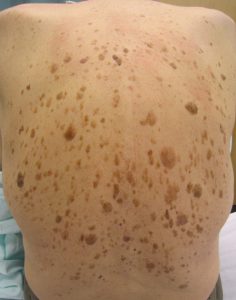Home » Laser Treatments » Mole/Lesion Removal
Primary lesions are changes in your skin that aren’t associated with other conditions the way it looks and where it appears can help to identify it :
What are skin lesions?
The term “skin lesion” refers to any skin area that is different from the surrounding skin.
Skin lesions may be raised like a cyst or flat like an age spot. They can be symmetrical like a wart or asymmetrical like melanoma. Some lesions, like skin tags, are the same colour as your skin, while other lesions can be darker, such as a mole.
There are many different types of skin lesions that you can be born with or acquire. Some are benign, which means they are harmless. Others can be severe and cancerous. They may appear all over your body, like hives, or they may be in one place.
If you have any concerns about a skin growth, it’s always a good idea to consult with a healthcare provider to ensure it’s benign and to discuss potential treatment options. Is there anything specific you’d like to know more about?
Freckles
Freckles are small, flat, light brown macules or patches on the skin, they are caused by sun exposure.
Most common freckles are harmless and rarely turn into skin cancer. They are more common in individuals with light, fair skin, or red hair.
Freckles do not require any treatment unless they change and skin cancer is suspected.
There are two types of lesions commonly called freckles:
Ephelides: these are typical freckles that occur from childhood, they are more common in those with fair skin and/or red hair. They tend to be round in shape and are various shades of brown.
Solar Lentigines: these are macules or patches with clear borders, they vary in shade from light brown to black. They are often known as sun spots, age spots, liver spots, or actinic lentigines. They ate caused by long term sun exposure and are more commonly seen in the older people.
Acrochordons – Skin Tags
Acrochordon are the most common skin lesion, and there is an increased frequency with age. They may arise as a result of repeated irritation to the skin, and are often seen in areas of chronic friction such as the neck, axilla, and groin.
Removal is not necessary and they do not normally require medical intervention unless they are causing cosmetic concern or in a position where they are irritating the skin.
Warts
Warts are caused by the human papillomavirus (HPV). They tend to occur in groups and are contagious.
Warts are also known as a verruca they are raised, flesh-colored papules and may contain tiny black dots in the center. They are not dangerous but can be painful and are easy to pass to others.
There are several different types of warts, including:
Warts can be extremely difficult to treat and often reoccur.
Complications of Warts
Warts don’t generally cause complications, but a few problems are possible. Among them:
Seborrheic Keratosis
Seborrheic keratosis is a common, non-cancerous skin growth that often appears as people age. These growths can vary in color from light tan to black and typically have a waxy or scaly appearance. They often look like they are “stuck on” the skin and can appear anywhere on the body, but are most commonly found on the face, chest, shoulders, or back.
Here are some key points about seborrheic keratosis:
Prices
Cost will be based on size and nature of lesion to be treated and will be charged per lesion.
We are unable to give prices for mole/lesion removal without first conducting a face to face consultation to confirm that the lesions to be treated do not require a scan (scans are checked by a consultant dermatologist for an additional charge) or GP letter prior to any treatment being carried out.
It maybe necessary to send some lesions to the laboratory for histology, this will incur an additional charge.

Location:
62 Commercial Gate, Mansfield, Nottingham, NG18 1EU